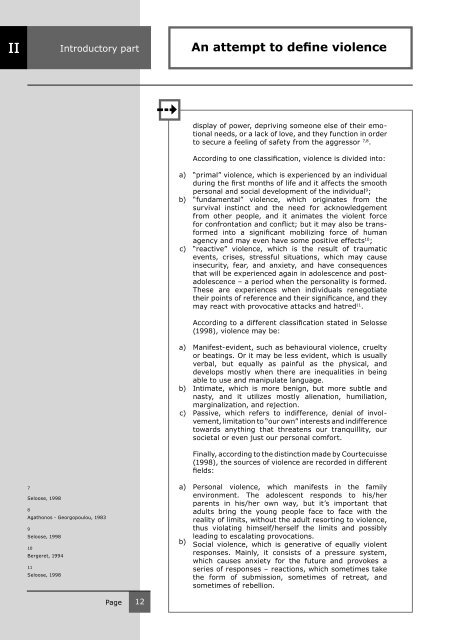Who are you? - Emergency Brake
Who are you? - Emergency Brake
Who are you? - Emergency Brake
You also want an ePaper? Increase the reach of your titles
YUMPU automatically turns print PDFs into web optimized ePapers that Google loves.
II<br />
7<br />
Seloose, 1998<br />
8<br />
Introductory part<br />
Agathonos - Georgopoulou, 1983<br />
9<br />
Seloose, 1998<br />
10<br />
Bergeret, 1994<br />
11<br />
Seloose, 1998<br />
Page 12<br />
a)<br />
b)<br />
c)<br />
a)<br />
b)<br />
c)<br />
a)<br />
b)<br />
An attempt to define violence<br />
display of power, depriving someone else of their emotional<br />
needs, or a lack of love, and they function in order<br />
to secure a feeling of safety from the aggressor 7,8 .<br />
According to one classification, violence is divided into:<br />
“primal” violence, which is experienced by an individual<br />
during the first months of life and it affects the smooth<br />
personal and social development of the individual 9 ;<br />
“fundamental” violence, which originates from the<br />
survival instinct and the need for acknowledgement<br />
from other people, and it animates the violent force<br />
for confrontation and conflict; but it may also be transformed<br />
into a significant mobilizing force of human<br />
agency and may even have some positive effects 10 ;<br />
“reactive” violence, which is the result of traumatic<br />
events, crises, stressful situations, which may cause<br />
insecurity, fear, and anxiety, and have consequences<br />
that will be experienced again in adolescence and postadolescence<br />
– a period when the personality is formed.<br />
These <strong>are</strong> experiences when individuals renegotiate<br />
their points of reference and their significance, and they<br />
may react with provocative attacks and hatred 11 .<br />
According to a different classification stated in Selosse<br />
(1998), violence may be:<br />
Manifest-evident, such as behavioural violence, cruelty<br />
or beatings. Or it may be less evident, which is usually<br />
verbal, but equally as painful as the physical, and<br />
develops mostly when there <strong>are</strong> inequalities in being<br />
able to use and manipulate language.<br />
Intimate, which is more benign, but more subtle and<br />
nasty, and it utilizes mostly alienation, humiliation,<br />
marginalization, and rejection.<br />
Passive, which refers to indifference, denial of involvement,<br />
limitation to “our own” interests and indifference<br />
towards anything that threatens our tranquillity, our<br />
societal or even just our personal comfort.<br />
Finally, according to the distinction made by Courtecuisse<br />
(1998), the sources of violence <strong>are</strong> recorded in different<br />
fields:<br />
Personal violence, which manifests in the family<br />
environment. The adolescent responds to his/her<br />
p<strong>are</strong>nts in his/her own way, but it’s important that<br />
adults bring the <strong>you</strong>ng people face to face with the<br />
reality of limits, without the adult resorting to violence,<br />
thus violating himself/herself the limits and possibly<br />
leading to escalating provocations.<br />
Social violence, which is generative of equally violent<br />
responses. Mainly, it consists of a pressure system,<br />
which causes anxiety for the future and provokes a<br />
series of responses – reactions, which sometimes take<br />
the form of submission, sometimes of retreat, and<br />
sometimes of rebellion.


